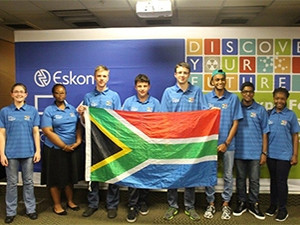
Brynn Cauldwell, a Grade 11 pupil from St Stithians Boys' College in Johannesburg, who this month participated in the prestigious annual Intel International Science and Engineering Fair (ISEF) in Phoenix, US, has done the country proud.
Cauldwell won the United Technologies Corporation Award at the event that ran from 8 to 13 May, and was awarded a prize of $3 000 from United Technologies Corporation for excellence in science and engineering.
The young scientist left for the US earlier this month together with seven compatriots to compete at the world's largest pre-college science fair competition.
The ISEF honours the world's most promising student scientists, inventors and engineers. Finalists are selected annually from hundreds of affiliated fairs. Their projects are then evaluated on-site by approximately 1 000 judges from nearly every scientific discipline, each with a PhD or the equivalent of six years of related professional experience in one of the scientific disciplines.
Cauldwell's project focused on finding sustainable solutions for acid mine drainage. It found that running water over concrete was the most effective way to raise the pH of water to a level where the water was usable for the irrigation of crops and plants.
The young scientist was one of eight talented school learners who represented SA at the science and engineering fair, having excelled at the 2015 Eskom Expo for Young Scientists International Science Fair. The fair provides a platform for primary and high school learners to showcase their scientific research projects and build their passion for science, technology, engineering, maths and innovation.
The other seven who also competed are Paul Stansell, Amber De Decker, Angus Thring, Nontutzeo Fuleni, Aryan Mootheeram, Maroclyn Arumugam and Lerato Metsing.
Some of the other great projects spearheaded by young South African scientists include using recycled and organic materials for energy, and safe disposal of household mercury containing compact fluorescent light bulbs.
Aryan Mootheeram, a Grade 11 pupil from Ladysmith, KwaZulu-Natal, used recycled and organic materials to create a fuel source that can be used for space heating by people living in rural areas who do not have access to, or have limited access to electricity. The fuel used recycled and organic materials easily sourced in rural areas in SA and was designed to be comparable in heat performance to traditional anthracite coal.
With compact fluorescent light (CFL) bulbs not being disposed of in an environmentally safe manner, Marcolyn Arumugam, a Grade 12 pupil from Durban, KwaZulu-Natal, designed and built an environmentally safe household CFL bulb disposal system that aimed to remove toxic mercury from the bulb.
The biggest winner at the fair was Han Jie (Austin) Wang, 18, of Vancouver, Canada, the recipient of the first place Gordon E Moore Award and $75 000 for developing microbial fuel cells (MFCs) that more efficiently convert organic waste into electricity.
Wang, who received the top honour, identified specific genes in genetically enhanced E. coli bacteria that enabled them to generate power efficiently. His system can produce significantly more power than existing MFC processes at a cost that is competitive with solar energy, which he believes will make MFCs commercially viable.
Syamantak Payra, 15, of Friendswood, Texas, received one of two Intel Foundation Young Scientist Awards of $50 000 for developing a low-cost electronically aided knee brace that allows an individual with a weakened leg to walk more naturally. When Payra tested his prototype with two individuals partially disabled by polio, it almost immediately restored a more natural gait and increased mobility.
Kathy Liu, 17, of Salt Lake City, Utah, received the other Intel Foundation Young Scientist Award of $50 000 for developing an alternative battery component that could significantly improve battery performance and safety. Liu's rechargeable battery is smaller and more lightweight, without the risk of fire inherent in lithium-ion batteries, which are used in planes, mobile phones and even hoverboards.
Share